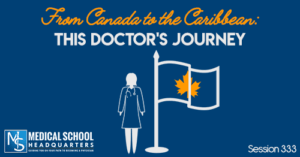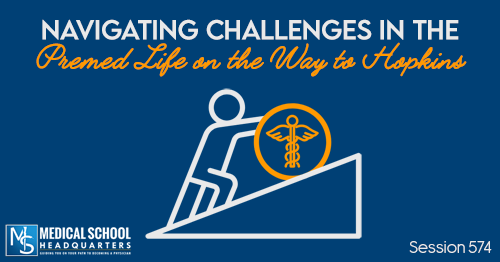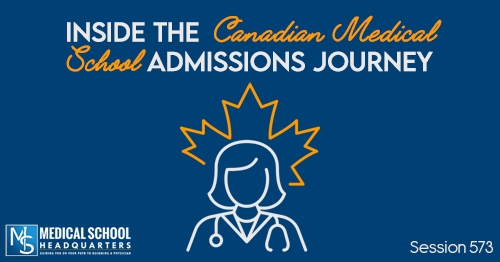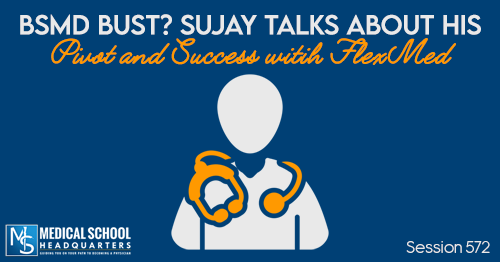Apple Podcasts | Google Podcasts

Session 333
Emma is Canadian, played D1 basketball in the U.S., and then went to Ross in the Caribbean for medical school. She is now starting her residency in the U.S. She takes us through her journey and shares helpful tips for Canadian students. I found Emma on Instagram with her handle @d1todr.
A lot of you are probably thinking about going to the Caribbean. Emma did poorly on the MCAT but did well in the Caribbean. She even matched at a very prestigious residency program in the states.
[02:25] Interest in Becoming a Physician
Emma went back to medical school at 27. But her interest actually stemmed from her sister having been diagnosed with both rheumatoid arthritis and Grave’s disease. They were on a vacation in Florida and her pills for her rheumatoid arthritis interacted with medication for Grave’s disease. She got so stiff that they had to bring her to the hospital. At that point, she wanted to know why that happened. This was that little seed that got planted onto her at 17. So she took the undergrad courses as premed, majoring in Biology.
She was playing D1 basketball at that time and she was told that it wasn’t going to be possible to do both basketball and the necessary science courses. Everyone basically said she wasn’t going to make it.
“When the ball stops bouncing one day, what do I have to show for it? I wanted a degree that I was proud of and that I wanted… I fought every single day to do my degree.”Click To Tweet[06:03] Shadowing in Canada
Volunteering was initially challenging for her during undergrad. So she went to Canada after undergrad and took some years to shadow at a local hospital as well as some volunteering. Especially in Canada, finding some shadowing opportunities can be very, very hard. What she found very effective was to volunteer first. She volunteered at a Queen’s University’s affiliate school in Ontario. So she volunteered at the health program at the hospital’s elder care program, where she was doing physical therapy exercises with elderly patients.
Volunteering allows you to meet doctors that come in and that’s when you can make those connections.
“Make sure you do volunteering and make those connections first and then the shadowing will happen after.”Click To Tweet[08:44] From U.S. to Canada to the Caribbean
Emma graduated with honors with a 3.7. She was the first of the players to graduate with a science degree. It was a nice feeling for her to be able to pass on stage and nod at her coaches, letting them know that she did it! However, she knew that applying back home in Canada was going to be tough. Although she did her undergrad in the U.S., she always knew she wanted to go to medical school in Canada with the dream to be an Olympic sports doctor. So she applied for two application cycles but both were unsuccessful. She got tired of waiting so she ultimately looked at the Caribbean route as she didn’t get any interview.
The Canadian application is very similar to the application in the U.S., but still it’s different. There’s no rolling admissions in Canada and no application services outside of Ontario. There are six medical schools in Ontario that’s why an application service helps – all six of which are part of the application service.
Emma applied everywhere. Out of 17 medical schools in Canada, four are in French. So you’re now only left with 13 options if you’re an English speaker and this just limits you incredibly. And there’s no point applying to those unless you’re a fluent French speaker.
[12:43] Canadian and CARS
One of the things that always comes up in the Premed Hangout Group is a student getting a 517 and having to take it. They forgot to mention they’re Canadian and their CARS score is only 127. A lot of the programs in Canada only take a certain part of the MCAT. For instance, McMaster University only takes the Verbal and Saskatchewan only takes Biology. So it’s tough to study for these exams since the overall grade doesn’t matter. A lot of the Canadian medical schools don’t even take the MCAT. But there are other parts of the application that you need to consider. As with McMaster, you have to make sure you do well on CASPer.
“The MCAT in the U.S. is what separates great and good students...it’s tough because there are less chances to prove that you’re worthy of it and that’s what’s really hurting in Canada.”Click To Tweet[15:15] Getting Rejected the First Time and the Feedback Process
The first time Emma applied, she already had volunteering done and the other extracurriculars. Thinking she had good leverage, she applied broadly and mass provincially but she didn’t get anything. She blames this on her poor MCAT score at 17 – which is really bad. She basically took it three times, and 19 was her highest.
So what went wrong? She was doing great during undergrad. And she couldn’t really pinpoint what she’s done wrong. She admits she didn’t really know how to study until she got to medical school. She did do an MCAT prep course to keep her on track.
“I didn’t really fully get the grasp of how to study, how to get this information in my brain. I just wasn’t a good standardized test taker.”Click To TweetDuring her first attempt, her mindset was that she was doing good in undergrad so the MCAT should be fine. But she didn’t pass. So she took a course before her third attempt and still only improved by two points. But then again, a lot of Canadian schools don’t look at the MCAT at all. So removing this factor from her application, she really couldn’t figure out what else could she have done better.
[19:00] Applying to U.S. Medical Schools and the Caribbean
Interestingly, Emma didn’t consider applying to U.S. medical schools. She heard of Ross though and wasn’t sure about the DO route either until she met a couple of DOs. Instead, she did apply to Ireland, Australia, and the Caribbean.
There are so much horrible things to be found on the internet about Caribbean schools and Emma highly suggests to not read them at all. This paved the way for her to start her blog and her social media presence to tell people that they can do it.
So she ended up applying to Ross. She listened to the seminars and she just loved it. She encourages students to go to seminars since this is a way for you to meet people. You get to meet several alumni and ask them specific questions.
When Emma applied four years ago, there was no real student’s perspective on the Caribbean route. That’s why she ended up starting a blog to answer questions each week.
[21:53] Fighting Against Nature and the Attrition Rate
During her time in medical school, the Caribbean was hit by hurricanes two times. Emma describes it as being tough. However, the really good thing about it is you have no distractions. You’re secluded and away from family and friends.
Emma gets asked a lot about the attrition rate. And she believes it’s not that high. There were 200 people in May 2015 when she started, and 180 in their class got off the island at the same time she did. The people who failed are the people who were there for family pressures. They think they’re just there to party and they have the money so they do it anyway. They’re also those people who aren’t sure if medical school is right for them. The attrition rate is high because of the people that don’t want to be there.
“If you want to do medical school and you’re not here because of family pressures, you’re not here just because you have money, you will pass and you will be fine.”Click To TweetRoss is one of the most prestigious schools in the Caribbean, Emma explains that the attrition rate is relatively high compared to the U.S. and Canadian medical schools. But look at who are the people failing. And even based on personal experience, Emma says she would already know who are the people who aren’t going to make it, even on the first day. So you just have to focus on yourself. There are people who are not taking it seriously and those are the people who fail.
[24:55] Finances and Loans
For Canadians who study abroad, you have to get a bank loan. Ross costs $24,000 (USD) every four months. Emma points out how the conversion rate is eating up the loan. Every time she paid her tuition, she’d lose $10,000. So it’s expensive. Their provincial loan, OSAP gives a maximum of $10,000 a year. It’s enough to pay your necessities. So you may have to get a bank loan. Examples are CIBC, TD, and RBC are the best three that she’s aware of.
“The conversion rate is what eats up your loan.” Click To TweetThe loans would usually give you a six-month grace period, enough time for you to get on your feet, grab a couple of paychecks, and then you get to decide how much you pay back. You can decide how much you want to put up towards the capital and how much towards the interest. The great thing about Canadian loans is that it’s only 2.3%. So the interest is not that bad.
[28:20] Rotations in Canada
Your third year of medical school is going to be at one hospital in the U.S. and fourth year, you can do as many electives as you want in Canada. They have 9 electives – each is composed of four weeks so it’s a total of 36 weeks. You can stay there for as long as you want.
The sad part is that the fourth year electives for the IMGs (International Medical Graduates) is done through a lottery system. So you don’t really know if you’re going to get it or not. And if you don’t get any in Canada, then you can still find some in the states.
The second time Emma was rejected in her application to Canadian school, she knew she wasn’t going to go back to Canada. She believes that if they’re not going to want her as a medical student, then they’re not going to want her as a physician. So as soon as she got into Ross, she knew she wanted to become a sports med doc in the states. And this has been her path since so she did her electives in the states.
[30:05] Picking Her Electives
During her fourth year, they were given a list of programs where they could choose to do their electives at. The IMF or the Internal Medicine Foundations is an 8-week course before you start your clinical rotations. At the start of IMF, Ross gave them a list of potentially starting clinical rotations at that time. Part of her thought process in choosing was to go to a state where her husband could also teach. So she had Chicago, New York, California, and Atlanta. He couldn’t teach in New York. They didn’t want to live in California and they didn’t want to live in Chicago, being sick of the cold. So she ultimately chose Atlanta, specifically Emery, which is an amazing sports med institution. She did two electives during her fourth year and she was just in love with it.
[32:00] Matching at a Prestigious School
Emma explains that what got her to Emery was really hard work during third and fourth year. She tried to meet as many people as possible. She also went to a sports medicine conference in Kansas City, which she highly recommends students should do. In fact, most of her interviews was about the conference. She was very active in their community. She would find out where Emery didactics were and she would show up. She also met the Associate Director of Sports Medicine Fellowship at Emery, who came to be her mentor in the past couple of years. She asked if she could do an elective with him and he was okay with it. So attending that conference gave her that connection. He also helped her get a Sub-I and he rooted for her. The interview went well and the rest was just history.
Emma is basically a perfect example of a student where it’s all about who you are as a person, not where you went to medical school. You just have to show yourself and be yourself. Go to conferences. Show your interest and involvement. Show your dedication. Put in the work and effort. She had gone to a Caribbean school but she didn’t let that limit her. More importantly, her attitude was how she really got through. She just didn’t take no for an answer.
“It’s all about who you are as a person, not where you went to medical school.”Click To Tweet[36:15] Caribbean as First Choice?
Emma wouldn’t recommend students to apply to the Caribbean right out of the gate. It took her two application cycles before she went to Ross. Instead, try in your home country. Try more than once if you want. Emma thinks she could have applied to Ross right after her first application. That said, there were students who went directly from college to Ross and they loved it. So it basically depends on where you are in your life and if you’ve tried back home.
“Definitely try back home and look for the Caribbean second.”Click To Tweet[37:33] Overcoming the Stigma
The only instance where Emma said she experience this was with these certain surgery attending physicians who were traditional. She feels that the stigma comes from the online forum. Because of this, it’s been her mission to create a safe haven on the internet for Caribbean grads and alumni.
There were a couple of states where the programs didn’t look favorably at Caribbean students. That’s okay. There are also those programs that are IMG friendly.
[40:00] Practicing in Canada
If you did your residency in the states and you want to practice in Canada, Emma explains that it’s specific to the residency program. For family medicine, it’s a 2-year training in Canada and three years in the states. In this case, you’re actually “over” trained which is good. You don’t have to do anything else. Internal medicine is four years in Canada and three years in the states, you’d actually have to do one extra year of training. Or you could do a year in fellowship and cross back over. If you want to do residency in Canada, you have to take four extra exams on top of your U.S. boards.
[41:50] Figuring Out How to Study
Ross offers the Medical Education Readiness Program (MERP) where they look at which areas a student need more prep on. The program basically ran for 15 weeks and Emma was glad she found her learning style. She realized she loves studying alone and just studying for herself. So she just learned to listen to lectures by herself and do things by herself.
“Find your study style early and stick to it.” Click To Tweet[44:26] Is the Caribbean Doable?
Emma says it is! It’s about who you are as a person. Put in the hard work and it’s definitely doable. Don’t worry about the name of the institution. Again, it’s about who you are as a person.
Links:
PMY Session 303: How Can I Prepare for the CASPer?
Emma on Instagram @d1todr
Checkout Emma’s YouTube Channel











